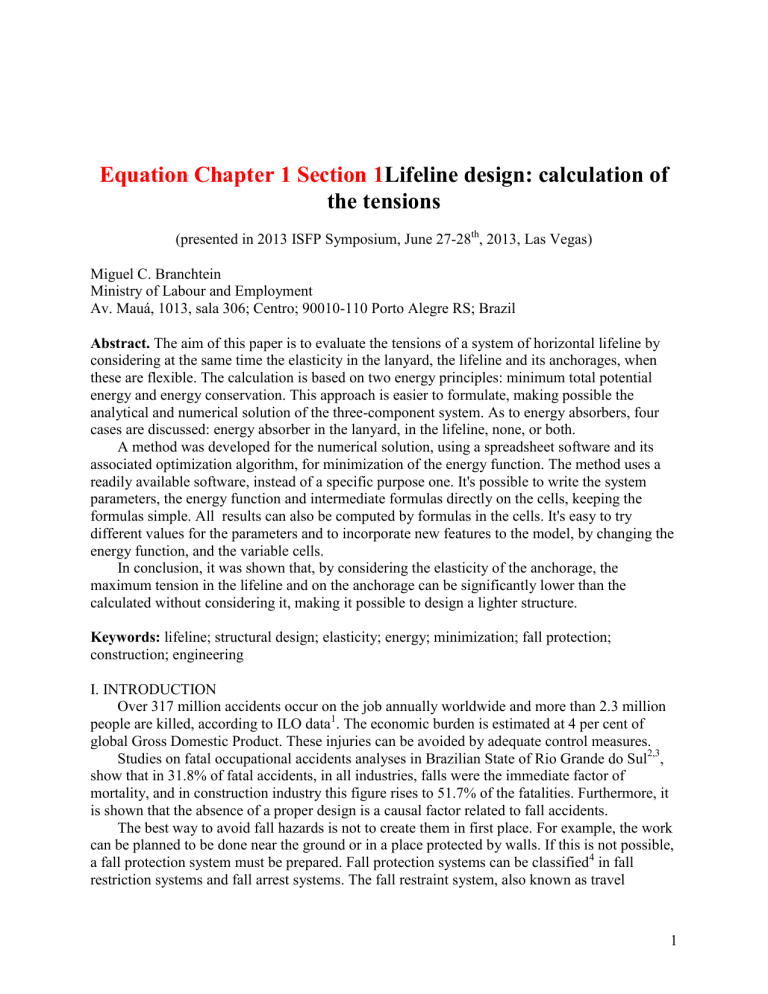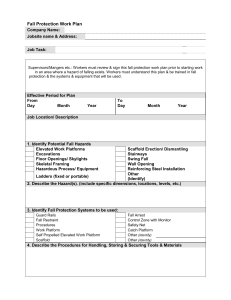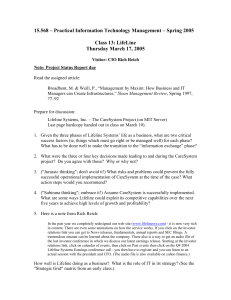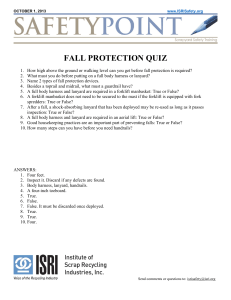
Equation Chapter 1 Section 1Lifeline design: calculation of the tensions (presented in 2013 ISFP Symposium, June 27-28th, 2013, Las Vegas) Miguel C. Branchtein Ministry of Labour and Employment Av. Mauá, 1013, sala 306; Centro; 90010-110 Porto Alegre RS; Brazil Abstract. The aim of this paper is to evaluate the tensions of a system of horizontal lifeline by considering at the same time the elasticity in the lanyard, the lifeline and its anchorages, when these are flexible. The calculation is based on two energy principles: minimum total potential energy and energy conservation. This approach is easier to formulate, making possible the analytical and numerical solution of the three-component system. As to energy absorbers, four cases are discussed: energy absorber in the lanyard, in the lifeline, none, or both. A method was developed for the numerical solution, using a spreadsheet software and its associated optimization algorithm, for minimization of the energy function. The method uses a readily available software, instead of a specific purpose one. It's possible to write the system parameters, the energy function and intermediate formulas directly on the cells, keeping the formulas simple. All results can also be computed by formulas in the cells. It's easy to try different values for the parameters and to incorporate new features to the model, by changing the energy function, and the variable cells. In conclusion, it was shown that, by considering the elasticity of the anchorage, the maximum tension in the lifeline and on the anchorage can be significantly lower than the calculated without considering it, making it possible to design a lighter structure. Keywords: lifeline; structural design; elasticity; energy; minimization; fall protection; construction; engineering I. INTRODUCTION Over 317 million accidents occur on the job annually worldwide and more than 2.3 million people are killed, according to ILO data1. The economic burden is estimated at 4 per cent of global Gross Domestic Product. These injuries can be avoided by adequate control measures. Studies on fatal occupational accidents analyses in Brazilian State of Rio Grande do Sul2,3, show that in 31.8% of fatal accidents, in all industries, falls were the immediate factor of mortality, and in construction industry this figure rises to 51.7% of the fatalities. Furthermore, it is shown that the absence of a proper design is a causal factor related to fall accidents. The best way to avoid fall hazards is not to create them in first place. For example, the work can be planned to be done near the ground or in a place protected by walls. If this is not possible, a fall protection system must be prepared. Fall protection systems can be classified4 in fall restriction systems and fall arrest systems. The fall restraint system, also known as travel 1 restraint systems, provides protection by setting restraints on workers to prevent the fall from happening. They act before the fall happens. The fall arresting system is designed to function when a worker is in the process of falling. It provides protection by catching the worker during the fall and fully stopping the fall before the worker hits the lower level or an obstacle. In general, the fall arresting system requires more complex engineering and more specially designed components, in order to limit the impact upon the worker to avoid the injury caused by the system itself. Workers require more training to use fall arresting systems and rescue plans are necessary. Fall protection systems can furthermore be classified in active and passive. Active systems depend on some action being done by the user. Passive systems work independently of any user action. In general, collective protection is passive and individual protection, active. An example of passive fall restraint system are the guardrails at the edges of floors that are not closed by walls. A passive fall arrest system would be a safety net in order to catch a person that fell from an unprotected edge. An active fall restraint system example is to use a waist belt tied to a horizontal lifeline or rail by a lanyard which length does not allow the user to reach the edge of an inclined roof. An active fall arrest system example is to use a safety harness tied to a horizontal lifeline by a lanyard with shock absorber, in order to walk on a beam from where one can fall. If a fall restraint system is feasible and offers complete protection, it is preferable to a fall arrest one. Likewise, a passive system is preferable to an active. One of the components that an active fall arrest or fall restraint system may have are horizontal lifelines. A horizontal lifeline (HLL) is a line that is stretched between two extremes of travel in a workplace, to provide a continuous anchor for the attachment of fall-arrest equipment. They are needed for several reasons, such as providing horizontal traveling and avoiding swing fall hazard. The basic quantities in HLL calculations are the tension in the lanyard and the tension in the line. The first one is usually determined like in any active fall arrest system. When the lanyard is equipped with an energy absorber, the tension in the lanyard is the absorber peak force. Otherwise, the tension is given by the so called Standard Equation for Impact Force 5. The tension in the line, however, in the case of flexible horizontal lifelines, is different from the tension in the lanyard, because the latter is transversal to the line6,7. Research on HLL, both theoretical and testing, has been made, since the seventies8,9,10,11, but still there are open questions. Horizontal lifeline design, specially for fall arrest, can be a difficult problem. The value of tension in the lifeline is usually high, specially for taut low-sag lines, which affects not only the dimensioning of the cable, but also of the anchorages. It's a nonlinear dynamical problem. Many parameters are involved where a small difference can largely modify the results. The parameters that will be dealt with in this paper are the elasticity in the lanyard, the lifeline and the anchorage. The elasticity of the lanyard increases arresting time and distance, thus reducing the arresting tension in the lanyard, and by consequence also in the line. The elasticity of the lifeline reduces the value of the tension in the line during fall arrest not only by increasing arresting time but mainly by augmenting dynamical sag. But in some cases the anchorages are also flexible. Then the tension can be further reduced by taking anchorage elasticity in consideration. The flexibility of anchorages had already been studied by McIntyre, Arteau, Lan and Corbeil12,13,14,15,16who, in tests using posts as the end-anchoring means, demonstrated that the degree of rigidity (or flexibility) of the end-anchor arrangement can affect performance. The weight of the anchor posts (in the order of 50 kg) created difficulties in handling and installation, hence the need to create a light and safe anchor pole capable weight to withstand the fall a 2 worker. To combine lightness and resistance, the post should undergo plastic deformation to absorb the energy of the fall. Paureau and Jacqmin17, by their turn, studied lifelines anchored in vertical posts, equipped with elastic devices, as springs, between the lifeline and the anchorage, in order to augment the lifeline sag during the fall arrest. The present paper is a theoretical study on horizontal lifelines fixed in anchorages that have some degree of flexibility, for example a vertical post that suffers a finite displacement when pulled by the lifeline cable during the fall arrest. The aim is to evaluate the tensions by considering at the same time the elasticity in the lanyard, in the lifeline and in the anchorage. II. FORMULATION We'll consider a system (fig. 1) with three components: 1. A vertical lanyard connected to the middle of 2. a horizontal lifeline, fixed in both ends to 3. the anchorages. We assume each component is elastic and weightless. The lanyard has an initial length l10 . When submitted to a tension T1 , it stretches to a final length l1 . Its variation is l1 l1 l10 . We assume it obeys Hooke's law, T1 k1l1 , where k1 is the spring constant. The same with the lifeline: T2 k2 l2 , where T2 is the longitudinal tension, along the cable. The anchorage is of a kind that will yield some lateral displacement when submitted to the horizontal tension from the lifeline. Like, for example, a metal pole with the bottom end fixed and the top end free. When an unitary horizontal force is applied, it yields a displacement . As this displacement occurs at both sides, the length of the span l30 diminishes twice this quantity: l3 l30 2 , for a unitary tension. Then, we can consider the span as a spring under compression: T3 k3l3 , where 1 l3 l30 l3 and k3 2 We want to calculate the lengths variations and the tensions in each component, at their maximum, in the moment when the falling mass momentarily stops before bouncing upwards. To do this, we will apply in the end of the lanyard a force F , equal to the tension in the lanyard at this moment. Then we will resolve the static problem rather than the dynamic one. 3 l3 0 α0 f0 l2 /2 0 l 2 0/2 l10 l3 α l 2 /2 f /2 l2 l1 F FIG. 1: The system is compound by a lanyard(1), a horizontal lifeline (2) and the span between anchorages(3). Above, the system unloaded, and below, the system subject to a force F. 4 So, the parameters (inputs) are: the elastic constants k1 , k2 , k3 (1) l10 , l20 , l30 (2) , the initial (unloaded) lengths , and the applied force F The variables (unknowns) are the length variations l1 , l2 , l3 which are to be determined. From them, we obtain the final (loaded) lengths l1 l10 l1 l2 l20 l2 (3) (4) (5) l3 l30 l3 and the final tensions (6) Ti ki li We apply an external force F , which later we'll make equal to the impact force, and try to find the distribution of lengths and tensions when the system is in equilibrium with this force. For this purpose, we use the principle of minimum total potential energy18, which can be stated as: Among all the possible displacements consistent with the reactions, the correct state of displacement is that which minimizes the total potential energy. This method is equivalent to the usual equilibrium conditions of null resultant force and moment, but sometimes leads to simpler calculations and permits a deeper physical insight. The elastic potential energy is k k k (7) U e 1 (l1 )2 2 (l2 )2 3 (l3 )2 . 2 2 2 The potential energy function of the external loads is: U F F ( f l1 ), (8) where f is the sag: 1 2 2 (9) f l2 l3 , 2 provided l2 l3 , which is always true, since the lifeline is attached to the anchorage. The total potential energy is U Ue U F . When the system is in equilibrium, this function is a minimum. (10) III. SOLVING A. Solving analytically 5 If the total potential energy function U is a minimum, than dU 0 , which means that every partial derivative must vanish: U (11) 0 k1 (l1 l10 ) F 0 l1 l2 U F (12) 0 k2 (l2 l20 ) 0 l2 2 l22 l32 U F 0 k3 (l30 l3 ) l3 2 l3 (13) 0 l l32 The force equations are obtained without dealing with vector components or trigonometry. It all comes out of the energy function. The first equation is already decoupled, and the other two form a set. From this set, the values of l2 and l3 can be obtained, at least numerically, and from them; T2 and T3 , and it's done. The following trigonometric relations can be drawn from lower figure 1: (14) cos l3 / l2 (15) sin 2 f / l2 and also, if l20 l30 , 2 2 cos 0 l30 / l20 Substituting (6), (9), (14) and (15) in (11) to (13), we get (16) T1 F F (17) T2 2sin F (18) T3 2 tan and from (17) and (18), T3 / T2 l3 / l2 cos (19) The force equations are obtained without dealing with vector components or trigonometry. The energy function has all the information about the system. Substituting eqs. (11) to (13), (14) and (15) in (7), we get: F2 1 1 1 Ue 2 2 2 k1 4k2 sin 4k3 tan Whence, the equivalent stiffness ke of the three springs system can be defined by 1 1 1 1 2 ke k1 4k2 sin 4k3 tan 2 The stiffness increases with the angle, 1 lim ke 0 from to . lim ke 0 /2 1 1 k1 4k2 6 From eqs. (12) and (13), doing some algebra, adding both equations and diminishing one from the other, we get: l3 l2 1 1 F (20) f 0 0 l3 l2 k2 k3 4 l20 k3tan( ) k2 k3 l30 k2 k3 l2 l3 Substituting (14) and (15) into eqs. (20) and (21): sin( ) 1 1 F tan( ) , l30 / l20 k2 k3 2l30 k2 (21) (22) sin( ) 2f (k2 k3 ) , l30 / l20 l30 (23) Eq. (22) corresponds to the equation derived by Paureau and Jacqmin19, where it is called the law of lifeline behavior. If l30 l20 ,we can define cos 0 l30 / l20 , where 0 corresponds to the initial angle. sin( ) 1 1 F , cos 0 k2 k3 2l30 sin( ) 2f k3tan( ) k2 (k2 k3 ) , cos 0 l30 tan( ) (24) (25) The angle is obtained from (24) (or from (22)). From (25) (or from (23)), the sag f is obtained. From (14), (15), (16), (17) and (18), we get l2 , l3 , T1 , T2 , T3 . 3 2.5 2 1.5 β 1 0.5 0 -0.5 -1 2.0 1.0 0.7 0.5 0 0.2 0.4 0.6 0.8 1 1.2 1.4 α (rad) FIG. 2: Graph of the function tan( ) sin( ) l3 / l2 0 In Fig. 1 we plot the function tan( ) sin( ) l3 / l2 0 , for several values of l3 / l2 0 0 0 , for several values of l3 / l2 . The final 0 0 0 angle that results from a applied force F can be determined as the value in the abscissa 7 1 1 F corresponding to a value in the ordinate. For l3 / l2 1 , the curves cut the k2 k3 2l30 abscissa in the value of the initial angle 0 . If l20 l30 , there is tension in the lifeline and in the anchorage when F 0 . Let's calculate 0 0 the tension in this situation. For l3 / l2 1 , and F 0 , we see in the fig. 2 that 0 , so the line is straight, and we have: (26) l2 l3 l From (19): (27) T2 T3 T From (26), (27), (5) and (6): l3 l2 (28) T 10 10 k2 k3 0 0 l k2l20 k3l30 (29) k2 k3 And the elastic potential energy is: T2 1 1 (30) 2 k2 k3 Having solved the problem for a given applied force, this one is made equal to the maximum impact force that occurs during the fall arrest. Now, we have to consider the presence of energy absorbers in the system. We assume an ideal energy absorber (fig. 3), in which, once the activation tension is reached, the energy absorber begins to yield and the tension Ta is kept constant until the absorber extension limit la,max is reached. U e0 T Ta l la,max FIG. 3: Ideal energy absorber of constant tension Ta and maximum extension la,max . There are four cases: energy absorber in the lanyard, in the lifeline, none, or both. 1. Energy absorber in the lanyard We identify the absorber yield tension Ta with the applied force F used in the calculation above, F Ta , then obtaining the results li , li , and Ti as above. 8 Then, we find the absorber extension la , using the energy balance: la mg y0 f l1 U e Ta mg , k k k U e 1 (l1 )2 2 (l2 )2 3 (l3 )2 U e0 , 2 2 2 and U e0 is zero, if l20 l30 , or U e0 is from (30), if l20 l30 . where (31) (32) If la 0 , then the lanyard energy absorber wasn't activated, and we proceed to the calculation as in the case with no absorber. If la la,max , this means that the lanyard energy absorber was fully torn and yet the mass did not stop. Then, we calculate as the case with no absorber, but diminishing Ta la / mg from the free fall distance, in order to discount the energy dissipated by the absorber, and adjusting l10 and k1 , as appropriate. 2. No energy absorber Let y0 be the height of the point of connection of the lanyard to the worker, before the fall, above the horizontal line that passes by the lifeline anchorages. The total fall distance, until complete stop, is y0 f l1 . During the fall, the gravitational potential energy converts into kinetic energy, which converts to elastic potential energy during fall arresting. In the moment of stopping, we can equate the gravitational potential energy variation U g and elastic potential energy variation U e : mg y0 f l1 U e 0 (33) At the same time, we have the maximum fall arrest force. So, we have to find the value of F for which condition (33) is fulfilled. 3. Energy absorber in the lifeline We set tension T2 in the lifeline equal to the tension Ta of the absorber. T2 Ta l From (19): T3 Ta 3 l2 T From (5) and (6): l2 l20 a la k2 T l3 l30 3 k3 From (34) to (37): l30 T3 l20 1 1 la Ta k2 k3 Ta (34) (35) (36) (37) (38) 9 T3 (39) l2 Ta 4f (40) T1 T2 l2 T (41) l1 l10 1 k1 1 2 2 (42) f l2 l3 2 The absorber continues to yield, extending la , thus increasing lifeline length and angle . l3 During this process, tension T2 is held constant, but tension T1 in the lanyard is increasing, because the angle is increasing. Eventually, the mass stops. We make the energy balance: laTa mg y0 f l1 U e (43) where U e is the same as in eq. (32). The right member of eq. (43) has terms that depend on equations (36) to (42), which depend on the absorber extension la , so, in order to find this quantity, all equations must be solved together. If la 0 , then the lifeline energy absorber wasn't activated, and we proceed to the calculation as in the case with no absorber. If la la,max , this means that the absorber in the lifeline was fully depleted and yet the mass did not stop. Then, we calculate as the case with no absorber, but adjusting the free fall distance, diminishing the energy dissipated by the absorber, Ta la / mg , and adjusting l20 and k2 , as well. 4. Energy absorber in both lanyard and lifeline The angle 2 for which both absorbers will be yielding is obtained from: Tly (44) sin( 2 ) 2Tll where Tly is the lanyard absorber yield tension and Tll is the lifeline absorber yield tension. If the initial angle 0 2 , then lanyard absorber fires first, the tension will be kept constant in both the lanyard and the lifeline, so the lifeline absorber will not fire. We proceed the calculation as in case 1. If 0 2 , then the lifeline absorber fires first. The lanyard tension will continue to increase as the angle increases. When the angle 2 is reached, the lanyard absorber's firing tension is reached, and it will begin to yield. In this moment, the lifeline absorber will stop yielding. We can evaluate the variables at the moment when 2 . From (5), (6), (14), (19),: l (45) cos( 2 ) 3 l2 T (46) cos( 2 ) 3 Tll 10 T3 l2 Tll T cos( 2 ) l3 l30 ll k3 T l2 l20 ll lll k2 The lifeline absorber extension lll when the lanyard yields is given by: l3 (47) (48) (49) l3 l2 1 1 (50) lll 0 0 1 l20 Tll k2 k3 cos( 2 ) If, from (45), we find that lll 0 , then the lifeline absorber doesn't fire, and the calculation is as in the section where only the lanyard has absorber. If lll lll ,max , then the lifeline absorber will be depleted before the lanyard's has been activated. The lanyard absorber extension lly is given by the energy balance: lly mg y0 f l1 U e Tll lll Tly mg , (51) where f is given by eq.(42), and l1 l10 Tly k1 B. Solving numerically with minimization algorithm in worksheet software. (52) We can solve eq. (22) numerically, finding the angle for a given applied force, and from it, all other quantities. But we can also go back to eq. (10), and minimize the potential energy function, directly obtaining the displacements. Any algorithm or software suitable for multivariable non-linear optimization can be used. In this paper, we have used the Microsoft Excel Solver. 1. Energy absorber in the lanyard In a worksheet, we write in the cells (fig. 4) the values of the parameters (1) to (3), where, in the case of lanyard with energy absorber, the applied force F is set to the maximum arrest force of the absorber. For the displacements li (4), which are the variables to be determined, we write initial guess values, let's say, 0. In other cells, we write the formulas (5) to (10). In the Solver parameters (fig. 5), we set the Objective cell to the total potential energy cell (10); choose "Min"; and set the Variable Cells, to the li (4). In Options, we uncheck “Assume linear model”, and we do check “Assume non-negative”. In a glimpse, we get the results (fig. 6), in the cells (4), the values of the displacements li ; in the cells (5), the final lengths li ; and, in the cells (6), the tensions Ti , in the lanyard, in the lifeline cable, and in the span, which is the horizontal force transmitted by the lifeline to the anchorage. We also calculate the absorber extension la , by using energy conservation equation (31). 11 FIG. 4: Write the values and the formulas in the worksheet. Fig. 5: Set Solver parameters and execute. FIG. 6: Results. 12 2. No energy absorber For the case without any energy absorber, we don't know a priori the impact force F in the lanyard. So, we try every value, finding the corresponding displacements and forces, and checking the balance between gravitational and elastic energy, by eq. (33), as discussed in case 2 of section A above, in order to determine which is the value of F that is consistent with the free fall distance. As before, we write in the cells the values of parameters (1) k1 , k2 , k3 , (2) l10 , l20 , l30 , and, for evaluating (33), also the mass m , the gravitational acceleration g , and the initial position of the worker y0 , measured above the line between anchorages. Then, we write, several values of (3) F , one in each line, as well as the corresponding guess values of the variables l1 , l2 , l3 , and the formulas for the quantities (5) to (10), and also the gravitational potential energy U g . We sum in a cell all the cells of the total potential energy (10) U of each line. Now, we set in the Solver parameters window this cell as the Objective cell to be minimized, and all of the cells of the displacements l1 , l2 , l3 of all lines as the variable cells. When we execute the target cell is minimized, all the cells of the total potential energy U (10) of each line will be minimized simultaneously, and the displacements in each line will become consistent with the corresponding applied force. Then, we compare the elastic potential energy with the gravitational potential energy in each line. When they are equal, the value of the force F of that line is the impact force consistent with the free fall distance, and all other quantities of that line will be the right ones. FIG. 7: Results for the case of none energy absorber. Each line corresponds to a guess value of impact force. The one that will really occur is the line where Ue = Ug, in this example, between 8100 and 8200 N. IV. DISCUSSION A. Comparing results 1. No energy absorber 13 We've ran the case of no energy absorber, as described in B.2 above, with the following parameters: TABLE 1: Parameters used in the example calculations. lanyard ref. 1 lifeline span sag rel. sag mass 2 3 f0 f0% m (kg) h=y0+l10+f0 ki 30000 1.20E+06 li0 1.2 6.23 8.00E+04 0.3053 4.92% free fall dist. 100 fall factor r=h/l10 1.8 1.5 6.2 For comparison, we've ran three cases. In the first case, the lengths of lanyard, the lifeline and the span could vary. In the second case, we didn't permit the span length to vary, simulating a rigid anchorage condition. This can be done by setting the Solver Variable cells only to l1 , l2 cells, and setting l3 0 . In the third case, we've permitted only the lanyard l1 to vary, keeping fixed the other two lengths. Below, we show only the right result line for each case (the one which satisfies energy conservation condition). TABLE 2: Results for the case of none energy absorber. i ii iii cases F (N) Δl1 Δl2 Δl3 l1 l2 l3 f f% e2% e3% T1 T2 T3 1, 2, 3 vary 8133 0.27 0.01 0.18 1.47 6.24 6.02 0.83 13.43% 0.20% 2.96% 8133 15241 14688 1, 2 vary; 3 fixed 10016 0.33 0.03 0.00 1.53 6.26 6.20 0.43 6.98% 0.48% 0.00% 10016 36207 0 1 varies; 2, 3 fixed 11320 0.38 0.00 0.00 1.58 6.23 6.20 0.31 4.92% 0.00% 0.00% 11320 0 0 We see that: a) The impact force calculated by the method in case (iii), 11320 N, reproduces the value obtained from the Standard Equation of the Impact Force for a mass and a lanyard in a fixed point: 2kr (53) F mg 1 1 , mg where k , the rope modulus in N, is given by the product of stiffness constant of the lanyard k1 , 30000 N/m, by its length l1 , 1.20 m and r is the fall factor r h / l10 1.8m /1.2m 1.5 . b) Case (ii) reproduces the result for the tension T2 in the lifeline that would be obtained if, departing from the impact force of T1 10016 N, we would apply iteratively the equations Fl (54) T2 2 4f and T2 (55) k2 However, if we would depart from the value obtained from eq. (53), 11320N, and apply iteratively (54) and (55), we would arrive on a 10% higher value for T2 . c) The impact force in the lanyard, T1 , in case (i) is 19% less than case (ii), which is 12% less than (iii), because the energy is partially absorbed by the elastic deformations of the lifeline and the anchorage. l2 l20 14 d) The tension in the lifeline, considering anchorage flexibility (case i) was 58% less than without considering it (case ii). This is so, not only because part of the energy is absorbed by the anchorage, which reduced the impact force in the lanyard, but also because of the greater sag (13.48% of the span, in case i, compared to 6.98%, in case ii). This is because the flexibility of the anchorage is bigger than that of the cable. In case (i), the cable stretched only 0.2%, while the span contracted 2.96%). 2. Energy absorber in the lanyard With the same parameters as the precedent case, and an absorber tension Ta of 6000 N, we've set the applied force F to that tension, again running three cases. In the first case, the lanyard, the lifeline and the span lengths could vary. In the second case, we didn't permit the span length to vary. In the third case, we've permitted only the lanyard l1 to vary, keeping fixed the other two lengths. The following results were produced. TABLE 3: Results for the case of energy absorber in the lanyard. i ii iii cases Δl1 Δl2 Δl3 l1 l2 l3 f f% e2% e3% T1 T2 T3 Δla 1, 2, 3 vary 0.20 0.010 0.15 1.40 6.24 6.05 0.76 12.24% 0.16% 2.40% 6000 12280 11908 0.17 1, 2 vary; 3 fixed 0.20 0.020 1.40 6.25 6.20 0.39 6.32% 0.32% 0.00% 6000 23803 0 0.24 1 vary; 2, 3 fixed 0.20 1.40 6.23 6.20 0.31 4.90% 0.00% 0.00% 6000 0 0 0.27 We see that: a) Case (ii) reproduces the result for the tension T2 in the lifeline that would be obtained if, departing from an impact force of 6000 N, we would apply iteratively the equations (54) and (55). b) The tension in the lifeline, considering anchorage flexibility (case i) was 48% less than without considering it (case ii). As the impact force in the lanyard is the same (because of the absorber), the difference is due to the greater sag (12.24% of the span, in case i, compared to 6.32% in case ii). This is because the flexibility of the anchorage is bigger than that of the cable. In case (i), the cable stretched only 0.16%, while the span contracted 2.40%). c) The absorber extension la , considering anchorage flexibility (case i), was 29% less than without considering it (case ii). This is because more energy goes to the elastic deformation, and less is left to the absorber. B. Limitations of the model and ways of improving it It will be necessary to make tests in order to validate the model. Many assumptions were made in order to make it easier to solve, even analytically. The testing can show how the method needs to be improved, by modifying some of these assumptions. The numerical procedure can be easily modified, by writing a different potential energy equation and choosing other variables. 1. It was used an static method for calculating a dynamical problem by introducing a fictitious applied force. It was used an equilibrium condition (the principle of minimum total potential energy) in order to calculate a system that is not in equilibrium. The mass has only momentarily stopped before bouncing back, and the different parts of the system might not be in equilibrium. 2. The principle of minimum total potential energy presupposes conservative forces, but parts of the system, as the energy absorbers, are dissipative. These were treated only by the energy balance. Other components, like the lanyard, present energy 15 dissipation along with elasticity. Should this be taken in consideration, then it might be necessary a different variational principle. 3. The elasticity of the connections wasn't considered. It was assumed a lanyard and a lifeline of a determined length of line with a homogeneous stiffness. The real line is made of many components: line, connections, cable loops, fasteners, each one with a different elasticity, and sometimes difficult to predict way of deforming. 4. It was assumed that the lanyard and the lifeline are perfectly elastic, with constant stiffness. Otherwise, fiber ropes are known to have viscoelastic behavior. Thus, the stiffness will be dependent not only on the elongation, but also, in part, on the elongation speed, and consequently on the falling body speed and on the free fall distance. Beside that, there is energy absorption by the lanyard during the fall arrest. Wire ropes are generally described as featuring a permanent stretch in the first loadings and an approximate elastic behavior after that, but there is not much information as to the dynamic behavior. In order to improve the model, the elastic k potential energy of the lanyard and the lifeline U ei i (li )2 could be replaced by 2 the integration of a polynomial adjusted from experimental data of the tensionelongation characteristics of the ropes, as proposed by Baszczyński 20. 5. The lifeline was assumed weightless. The self-weight contributes to increase the tension in the line, by increasing the load, and by changing the shape of the line. In the numerical solution, it's possible to consider the self-weight in a discrete mode, adding some loaded points between the center and the extremes, building a correspondent energy function, and allowing their positions to vary both horizontal and vertically. 6. Only elastic deformation of the anchorage was considered. In real lifelines, sometimes there are some movements during fall arrest that are non linear elastic, due to gaps, rotations, etc. 7. We assumed constant force energy absorbers. Usually, there are ups and downs. An easy improvement is to consider the peak value of the force as the force applied, for the tensions calculation, but use the average value of the force for the absorber length extension calculation. 8. Sensibility to adjustments: it may be difficult that the parameters used in the calculation are properly set in the work site, and kept constant after that. This difficulty is not specific of the present model. 9. Cases that were not treated in the present model: a. Falls not in the middle of the span b. Multiple spans c. Simultaneous or sequential falls d. Falls not directly below lifeline 10. Limitations of the optimization software21: a. A nonlinear problem may have more than one minimum, then, sometimes the software may find a solution that is not the physical one searched. We have to keep this in mind when examining the results. It's a good idea run the Solver starting from several different sets of initial values for the variables. 16 b. Sometimes, the program stops the search short of the minimum searched. In this case, we run it again, departing from the result found; the energy function will decrease a little bit more, and the result will change a little bit. c. The optimization software embedded in the spreadsheet used can deal with a maximum of 200 variable cells. If necessary a greater number, it can be used another software, or a program may be written to do the minimization. V. CONCLUSIONS A. The model computes the values of the tensions in each component, by considering conjointly the elasticity of the lanyard, the lifeline and the anchorage, and their effects on the energy absorption by each component and on the sag. B. It was shown that, by considering the elasticity of the anchorage, the maximum tension in the lifeline and on the anchorage can be significantly lower than the calculated without considering it, making it possible to design a lighter structure. It is also possible to design anchorages with an appropriate flexibility, in order to reduce the tensions. C. When the anchorage deflection is blocked, the results of the proposed method coincide with the results of the usual methods for horizontal lifeline calculation. D. The energy approach proposed is easier to formulate, making possible the analytical and numerical solution of the three component system. E. The method developed, using a spreadsheet software and its associated optimization algorithm, for energy function minimization, has several advantages: 1. It uses a readily available software, instead of a specific purpose one. 2. It's possible to write the system parameters, the potential energy function and intermediate formulas directly on the cells, keeping the formulas simple. All the results can also be computed by formulas in the cells. 3. It's easy to try different values for parameters. 4. It's easy to incorporate new features to the model, by changing the energy function, and the variable cells. F. Testing is necessary to confirm the expected system behavior and to validate the method, and/or to improve it. REFERENCES: 1 ILO. Safety and health at work. Available in http://www.ilo.org/global/topics/safety-and-health-at-work/lang-en/index.htm. Accessed in 2013-05-19. 2 Brasil. Ministério do Trabalho e Emprego. Superintendência Regional do Trabalho e Emprego no Rio Grande do Sul. Análises de acidentes do trabalho fatais no Rio Grande do Sul: a experiência da Seção de Segurança e Saúde do trabalhador – SEGUR. MTE/SRTE-RS/SEGUR, Porto Alegre, 2008. Available in http://wikitrabalho.agitra.org.br/sst/arquivos, accessed on 2013-06-14. 3 M. C. Branchtein, G. L. Souza, Análise de acidentes do trabalho na indústria da construção no Rio Grande Do Sul entre 2002 e 2009, presented in VI CMATIC – National Congress on Work Environment and Conditions in the Construction Industry, Belém do Pará, Brasil, December 6th to 9th, 2009. Available in http://wikitrabalho.agitra.org.br/sst/arquivos, accessed on 2013-06-14. 4 A.C. Sulowski. Fall protection systems classification, in : Fundamentals of fall protection. edited by A. C. Sulowski, (International Society for Fall Protection, Toronto, 1991), Ch. 12. pp. 285-301. 5 Richard Goldstone, The Standard Equation for Impact Force, Department of Mathematics and Computer Science, Manhattan College, Riverdale, 2006, available in http://www.rockclimbing.com/cgibin/forum/gforum.cgi?do=post_attachment;postatt_id=746, accessed in 2013-06-14. 17 6 H. Max Irvine, Cable structures, MIT Press, Cambridge, 1981. 7 G. L. Souza and M. C. Branchtein, Dimensionamento de sistema de cabo de aço sujeito a uma ação transversal, presented in VI CMATIC – National Congress on Work Environment and Conditions in the Construction Industry, Belém do Pará, Brasil, December 6th to 9th, 2009. Available in http://wikitrabalho.agitra.org.br/sst/arquivos, accessed on 2013-06-14. 8 N. Miura and A. C. Sulowski, Introduction to horizontal lifelines. in : Fundamentals of fall protection. edited by A. C. Sulowski, (International Society for Fall Protection, Toronto, 1991), Ch. 11, pp. 217-283. 9 Jean Arteau, André Lan, Protection contre les chutes de hauteur - Conception de câbles de secours horizontaux, IRSST, Montréal, 1991 10 Baszczyński K, Zrobek Z. Dynamic performance of horizontal flexible anchor lines during fall arrest -- a numerical method of simulation. JOSE 2000;6(4):521-34. 11 D Riches, A review of criteria concerning design, selection, installation, use, maintenance and training aspects of temporarily-installed horizontal lifelines, HSE, London, 2004 12 Georges McIntyre and Jean Arteau, Conception d'ancrages pour les câbles de secours http://www.irsst.qc.ca/projet-conception-d-ancrages-pour-les-cables-de-secours-0091-0100.html 13 Arteau, J. and Lan, A. Use of Horizontal Lifelines in Structural Steel Erection, Proceedings of the Conference on Protective Equipment, May 3-5 1992, Ottawa, Canadian Council on Protective Equipment, 1992. 14 Arteau, J. and Lan, A. (1994) Use of Horizontal Lifelines in Structural Steel Erection, Proceedings of the International Fall Protection Symposium, October 27-28 1994, San Diego, California, International Society for Fall Protection, Toronto. 15 Jean-Francois Corbeil, Ancrages deformables pour une ligne d'assurance horizontale, Ecole Polytechnique, Montreal (Canada), ProQuest, UMI Dissertations Publishing, 1995. MM08184. 16 Corbeil, J. F., Arteau, J. and Lan, A. (1996) Static and Dynamic Testing of Tubular Sections in Bending Collapse: Experimental Model, Proceedings of the 8th International Congress on Experimental Mechanics, Society for Experimental Mechanics, Nashville, 10-13 June 1996. 17 J. Paureau, M. Jacqmin, Lignes de vie. Spécifications. Essais, Cahiers de notes documentaire - Hygiène et sécurité du travail - N°173, 4e trimestre 1998, pp. 413-428 18 Don S. Lemons, Perfect Form: variational principles, methods, and applications in elementary physics, Princeton University, Princeton, 1997. 19 See Ref. 17, pp. 417-418. 20 Krzysztof Baszczyński, Dynamic Strength Tests for Low Elongation Lanyards, International Journal of Occupational Safety and Ergonomics (JOSE) 13 (1), 39–48 (2007). 21 Frontline Systems Inc. Standard Excel Solver - Limitations of Nonlinear Optimization, in http://www.solver.com/standard-excel-solver-limitations-nonlinear-optimization. Accessed on 2013-06-12. 18





